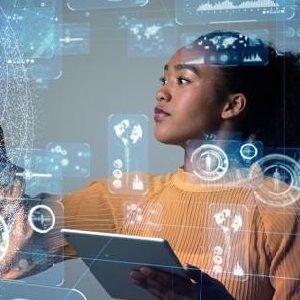How the Metaverse is Redefining Human InteractionPosted by Archi Jain on November 23rd, 2023  IntroductionHave you ever imagined a world where technology and human interaction merge seamlessly? A world where virtual and physical realities intertwine, blurring the boundaries between what is real and what is not. This is the concept of the Metaverse, a term coined by Neal Stephenson in his science fiction novel "Snow Crash" published in 1992. The Metaverse, a portmanteau of "meta" (meaning beyond) and "universe", refers to a digital space where users can interact with each other, create their own virtual identities, and engage in various activities. It is essentially a collective virtual shared space that mimics the physical world but with unlimited possibilities. Humanmachine interaction has evolved tremendously over the years, from traditional computers to smartphones to now the integration of Artificial Intelligence (AI) and Internet of Things (IoT). The Metaverse takes this interaction to a whole new level by creating an immersive experience where users can control their virtual environment through natural body movements using devices such as VR headsets and haptic suits. The emergence of the Metaverse marks a shift from traditional technology, which serves as tools for communication and information, to an all encompassing immersive experience. Unlike other forms of virtual reality or augmented reality, which require specific hardware or software, the Metaverse aims to be accessible through any internet connected device, making it easier for people from all walks of life to participate. Advancements in Technology
AI and ML have seen significant advancements, especially in natural language processing, computer vision, and autonomous systems. AI is being applied in diverse domains, including healthcare, finance, manufacturing, and customer service.
The deployment of 5G networks is underway, offering faster and more reliable wireless communication. This technology is expected to support the growth of the Internet of Things (IoT) and enable new applications such as augmented reality and autonomous vehicles.
Progress in quantum computing research has been notable. While large-scale, practical quantum computers are still in development, there have been breakthroughs in quantum supremacy and quantum algorithms.
Advancements in biotechnology, including the CRISPR gene-editing technology, have opened new possibilities in healthcare, agriculture, and other life sciences. CRISPR allows for precise modification of genes and has potential applications in treating genetic disorders. Emergence of New Forms of CommunicationVirtual Worlds:
Avatar-Based Communication:
Spatial Audio:
Haptic Feedback:
Breaking Physical Barriers
The metaverse allows people from around the world to connect and interact in shared virtual spaces. Geographical distances become irrelevant, enabling global collaboration, communication, and socialization.
The metaverse provides a virtual workspace where individuals can collaborate, conduct meetings, and work together in a shared environment. This is particularly significant for remote work, allowing teams to collaborate seamlessly regardless of their physical location.
Physical limitations on attendance are eliminated in the metaverse. Virtual events and conferences enable participation from anywhere, reducing the need for travel and making knowledge-sharing more accessible.
The metaverse can transform education by offering immersive and interactive learning experiences. Students and educators can engage in virtual classrooms, workshops, and simulations, breaking down barriers to education caused by geographical constraints. Blurring Lines Between Virtual and Reality
Overlaying Digital Information: AR enhances real-world experiences by overlaying digital information onto the physical environment. AR applications can provide contextual information, navigation details, or interactive elements seamlessly integrated into the user's perception of reality.
Immersive Simulations: VR technologies create immersive simulations that transport users to virtual environments, making them feel present in a computer-generated world. This blurs the line between physical and virtual spaces, offering new possibilities for entertainment, training, and collaboration.
Integration of Real and Virtual Elements: MR combines aspects of both AR and VR, allowing digital and physical elements to coexist and interact in real time. This integration creates experiences where virtual and real-world elements seamlessly blend.
Persistent Virtual Spaces: The metaverse represents a collective virtual shared space that blurs the boundaries between physical and virtual reality. Users can engage in shared experiences, socialize, and conduct various activities within persistent virtual worlds. Risks and Potential Drawbacks
You can also read:Like it? Share it!More by this author |


